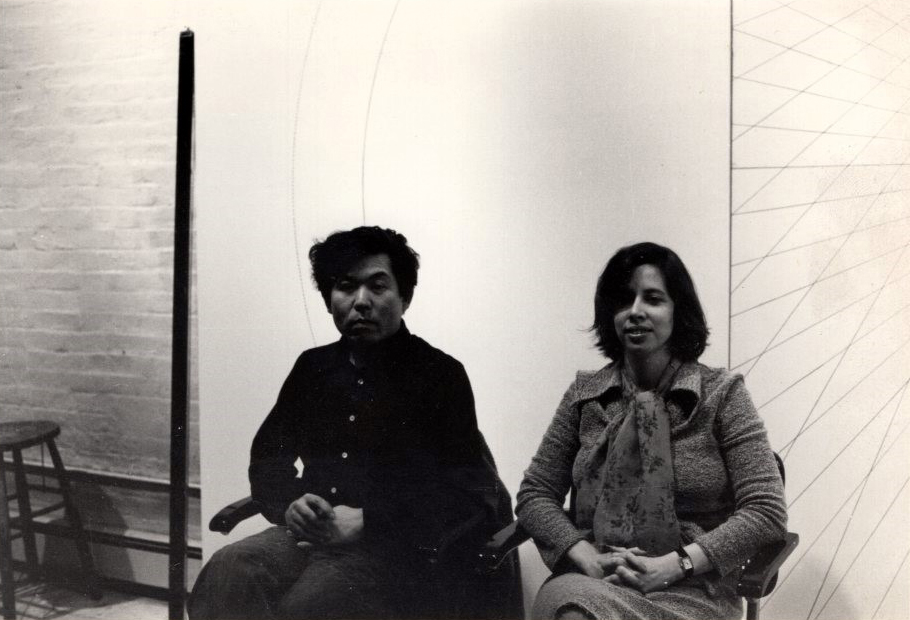
Dear Friends,
The new year brings with it the twelfth edition of our Ambiguous Zones newsletter, written by guest author Chaeeun Lee who thoughtfully considers Arakawa and Madeline Gins’s concept of Blank. Chaeeun is a PhD Candidate in Art History at CUNY Graduate Center and a research intern at the Reversible Destiny Foundation. She is writing her dissertation on the politics of abstraction and aesthetics in the work of Asian American and Asian immigrant artists during the 1960s and the 1970s, exploring the ways in which their work problematized the established norms of racial, cultural, and gender identification in search of alternative constructions of the self and the world. Chaeeun’s beautiful essay offers readers an accessible introduction to Blank that serves as a novel way to meditate on seasonal themes of fresh starts and shifting perspectives.
Yours in the reversible destiny mode,
Reversible Destiny Foundation and the ARAKAWA+GINS Tokyo Office
“LOUDLY THERE AND SHIFTING ABOUT AND TUMBLING INTO VIEW”: TRACING BLANK IN THE WORK OF ARAKAWA AND MADELINE GINS, 1968-1982
by Chaeeun Lee
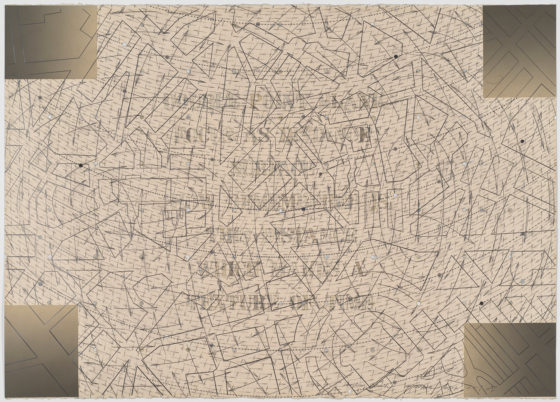
In Arakawa’s Study for “Shifting Blank,” a legion of tiny arrows forms layers of swirling
patterns that fill the entirety of the canvas. In the background is a diagram of a city map, overlaid with a block of text on a neutral-toned ground (Fig. 1). The work is part of a body of drawings and paintings created circa 1980 that drew on the term Blank, which began to appear frequently in Arakawa and Gins’s work starting in the mid-1970s. Contrary to the term’s implication of absence, the multidirectional arrows seem to indicate an abundance of movement and energy that overflows the boundaries of the city, rendering their Blank paradoxically full.
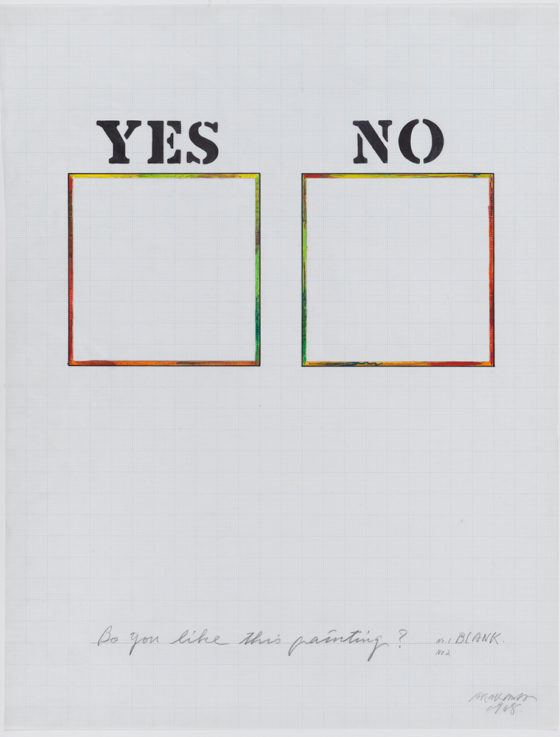
The history of Arakawa and Madeline Gins’s engagement with Blank may be traced to the 1960s, evidencing the centrality of this concept to their broader artistic and intellectual journey. A drawing by Arakawa titled Blank (1968) presents the viewer with two blank check boxes labeled “YES” and “NO” along with an unexpectedly simple question that debunks the pretense of objectivity in art appreciation, “Do you like this painting?” (fig. 2). In the spring of the following year, Arakawa and Gins participated in “Street Works,” a series of happenings by artists and poets convened by Vito Acconci and Bernadette Mayer. During the event, Gins handed out to passersby a questionnaire full of blanks to be filled in and mailed back to her, which would become part of “a group novel” that would explore “the nature of consciousness”[1] (fig. 3). What at first sight looks like an ordinary questionnaire asking for the responder’s name and age quickly reveals itself as a series of provocations that compel radically unorthodox manners of self-reflection. Midway through the text reads:
I move according to ____________________________. I am composed of ____________________________ and _________________. This falls into _____ parts. The heaviest part to move is ______________.
I felt my thoughts to physically be in (out) ___________________________ (Be Specific). The material of which they are made is _________________ which operates ___________________________.
Here, the blanks stir up an inquisitive attitude directed toward our existence and functioning as humans, which we are habituated to perceive as given or unknowable: What moves us (physically or emotionally)? What are we made up of (biologically or spiritually)? Where do our thoughts reside, and how do we feel their presence? The open-ended nature of the blanks and the unconventional angle of approach evidenced by Gins’s sentence fragments invite a myriad of creative answers to these questions, a good example of which is the whimsical, somewhat comical, response she received from Robert Cordier (fig. 3). In these early experiments by Arakawa and Gins, blanks appear literally as unmarked boxes or holes in sentences that are constituent parts of their works. Urging the audience’s response yet not so easy to fill in, the blanks function as a questioning device in the manner of the interactive, game-like panels in The Mechanism of Meaning (1963-71), which was at the time a work-in-progress.[2]
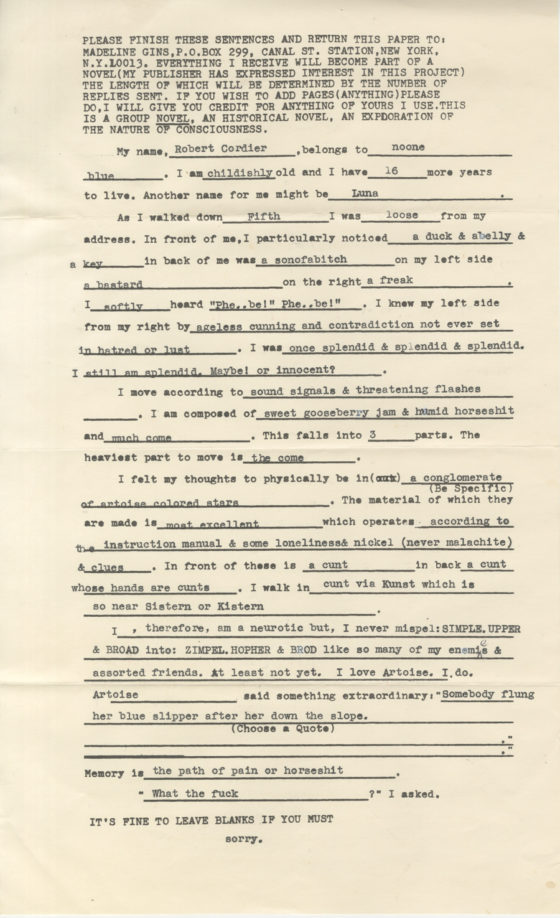
Between 1973 and 1980, Arakawa and Gins’s inquiry into the Blank sharpened through a compound word “point-blank.” In Arakawa’s 1973–74 painting Point Blank, densely arrayed beams emanate from six cylindrical forms[3] located along the sides of the canvas, rendered in primary colors and in grayscale (fig. 4). Behind the intersecting lines that spread through the entire field, the following text is stenciled in white: “POINT BLANK: / DISTANCE OF FOCUS, / HOW ANONYMOUS IS / THIS DISTANCE / WHICH IS A TEXTURE.” As is the case with many of the couple’s invented aphorisms, the meaning of the text is not instantly decipherable. Yet what is clear in its repeated invocation of the distance of point-blank is an interest in challenging the perceived immediacy associated with the term—what mysteries and complexities might lie in the space between the main actor and the target, no matter how close they seem to be? This is further confirmed in the preface to the 1979 edition of The Mechanism of Meaning, in which Arakawa and Gins clarify their aims to investigate “what takes place . . . when anything is ‘thought through.’”[4] “What is emitted point-blank at a moment of thought, anyway?” ask the artists, seeking to scrutinize the seemingly instantaneous mental process we call “thinking.”[5]
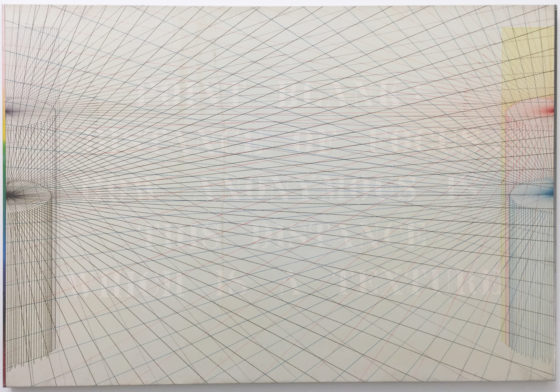
An unpublished sketch by Arakawa evinces that his focus was already moving on to the concept of “blank” itself by 1975 (fig. 5). On both the front and back of the paper, Arakawa drew spinning conical forms from which numerous lines extend out, a variation, it seems, on the cylinders from Point Blank (1973–74). Underneath one of the drawings he scribbled the following: “Who is sending blank?!! / Mystery which comes through clarification / Lines cannot contain moment of representation / Possibility of experience.” In some of his later works, such as Distance of Forming/Model by Model/The (1978–79) and Voice Drinker / The Artificial Given (1978–79), Arakawa implemented the motif of spinning cones in a more complex form while raising the question of “who” in a still enigmatic manner (a line from the stenciled text goes “BOTH SENDERS AND RECEIVERS CONFIGURATIONAL COVERINGS . . . ”) (fig. 6). Moreover, his notes provide a glimpse of the continuity in his conceptualization of Blank—that Blank is what is uncharted (mysterious) and filled with possibilities, and that knowing this unknowability is itself a form of enlightenment (clarification).
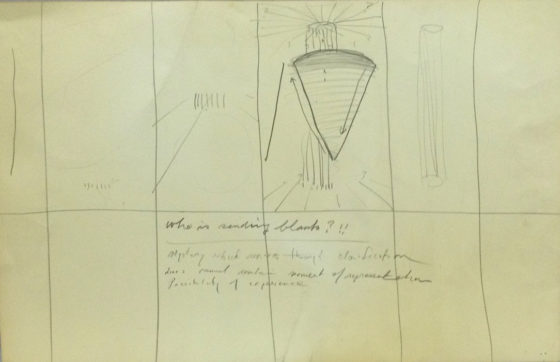
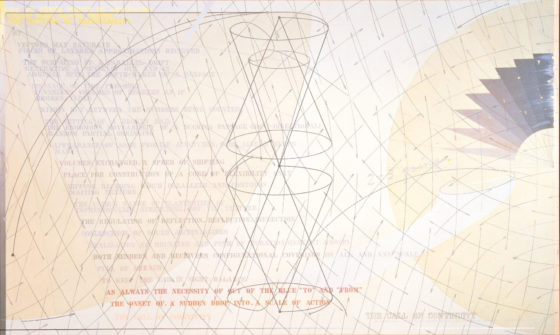
One of the major documents on Blank in its mature stage of development is the 252nd issue of Derrière le Miroir (1982), the French art magazine founded by gallerist Aimé Maeght. Published on the occasion of Arakawa’s solo show at Galerie Maeght, the issue contains a short text by Arakawa and Gins titled “Properties of Blank” along with nine full-page reproductions of Arakawa’s recent paintings and drawings. A sort of treatise on Blank, the text seeks to explicate the concept, describing it as an “area” or “activities” therein that are “non-activated,” “unspecified,” and “capable of behaving in many different ways at once,” and are integral to our subjectivity as a “neutralizing” or “changing” force.[6] In other words, Blank is an open-ended sphere of activity that is already part of us, which has a potential to upturn what we perceive as given ways of thinking, feeling, and acting. As such, Blank is distinguished from any implication of nonbeing, as the authors make it clear through a series of comparative exercises.
Void, Nothingness, Emptiness, Tabula Rasa, Vacuum. None of these quite covers what we wish to point out by the notion “Blank.”
First of all, Blank is above all a neutral positing—in the sense of a holding open; it is what is there but undifferentiated, so it is not nothing; it can accumulate: it is not void. It probably has its own laws of operation, so it, itself, is not a “tabula rasa.” It is what fills Emptiness. It may draw upon or feed whatever it is the vacuum is but is not identical with it.[7]
Interestingly, the text is followed by a string of excerpts from a variety of thinkers, writers, and scholars from across time and regions, ranging from Aristotle to Laozi, and from Swami Nikhilananda (a Hindu spiritual leader) to Edwin Boring (an American psychologist). They amount to a total of 32 authors with 47 excerpts, attesting to the breadth of readings Arakawa and Gins had immersed themselves in over the course of their ongoing research. Reading these excerpted texts closely, it becomes apparent that they speak similarly of human consciousness, sensory perception, cognitive process, and language, particularly from the point of view of a skeptic. They question the reliability of the mind’s operation (“Thus that in the soul which is called mind . . . is, before it thinks, not actually any real thing. – Aristotle”); explore counterintuitively the activity of non-activity (“Tao never does; Yet through it all things are done. – Tao Tê Ching”); and pursue alternative approaches to understanding human consciousness (“Whatever conscious content can be easily reported is focal and available to introspection. What cannot be reported at all is unconscious. Is there some intermediate level, some marginal zone? – Edwin Boring”).[8]
Compiling these quotes from a range of sources, Arakawa and Gins have created a transdisciplinary, transhistorical, and transcultural archive of thoughts around their concept of Blank. By inserting their own contribution into this archive, they stake out a position for themselves within the framework of this global collective intellectual pursuit. It is my suggestion that this archive is in a way enacting “forming Blank,” in that its transdisciplinarity, transhistoricism, and transculturalism counteract—“neutralize”—the normative methods of categorizing and interpreting knowledge. Against the modern era’s prevailing tendency to compartmentalize and classify according to a linear sense of time and space, their collection of ideas is mixed together almost haphazardly, without a clear organizational scheme, allowing unexpected similarities and resonances to emerge amongst them. The boundaries that tend to structure our ways of thinking, such as between art and science, between the ancient and the modern, and between what is considered the “East” and the “West” become obscured, and we encounter the thought fragments openly as being “there but undifferentiated.”
The transculturalism of this archive is particularly noteworthy given how their exploration of Blank risked being misunderstood as a manifestation of Arakawa’s “Asianness.”[9] While the element of culture seldom appeared as an explicit subject in their work, there is sufficient evidence that they were keenly aware of and critically responding to the cultural essentialism surrounding artists of Asian descent.[10] The following remark by Gins in an email exchange with Martin E. Rosenberg encapsulates this point.
[Nicolas Calas] became upset and annoyed when Arakawa started discussing and evoking blank on his canvases. “It will hurt your trajectory as an artist to do so. People will toss you back into the oriental pile. They will cease admiring you as a critical artist.” Although Arakawa, who loved Nicolas Calas and respected his judgment, admitted the grave danger he faced, he went on writing about and painting blank. His blank was, in any event, a critical blank.[11]
The collection of excerpts demonstrates that despite this “grave danger,” Arakawa and Gins not only kept on working with Blank but also continued to evoke the voices of Asian thinkers and masters. Instead of categorically rejecting sources from Asia, which would have inadvertently confirmed the view of Asia’s “otherness” (i.e. its incompatibility with “critical art”), this gathering of ideas affirms their place in this transcultural dialogue while subverting the very binarism of “East” and “West.”
From blank check boxes and a questionnaire to conceptual explorations of “point-blank” and of Blank itself, Arakawa and Gins’s attempt to explicate and materialize Blankness took various forms. In the course of these endeavors, they methodically questioned diverse aspects of reality that one tends to take as givens, including the construction and operation of our body, taste, and mind, and the ways we classify culture and knowledge. Instead, they envisioned Blank as a neutral and open state full of not-yet-concretized energies and possibilities, like the swarming arrows that keep on moving in all directions, permeating our existence in space-time. In this sense, perhaps Blank is a concept farthest away from the condition of absence or lack that we tend to associate with the term. In their work as well as in our daily lives, if we train our senses enough for it, we might recognize Blank to be, in Gins’s words, “loudly there and shifting about and tumbling into view.”[12]
[1] See Lucy Ives, “EVERYTHING I RECEIVE WILL BECOME PART OF A NOVEL: An Introduction to the Work of Madeline Gins,” in The Saddest Thing Is That I Have Had to Use Words: A Madeline Gins Reader, ed. Lucy Ives (Hudson River Valley, NY: Siglio, 2020), 12–15.
[2] This “fill-in-the-blanks” type of question continues to be utilized in Madeline Gins’s later work, sometimes with an explicit reference to the concept of Blank. One example begins with a sentence “Feeling blank is __________.” See Gins, What the President Will Say and Do!! (Barrytown, NY: Station Hill, 1984), 118.
[3] While the two furthest back shapes may not immediately read as cylinders, I am interpreting them to be a set of perfectly angled frontal renditions of the same cylindrical forms as the others.
[4] Arakawa and Madeline Gins, preface to The Mechanism of Meaning: Work in Progress (1963–1971, 1978) Based on the Method of Arakawa (New York: Harry N. Abrams, Inc., 1979), n.p.
[5] Ibid.
[6] The issue was published in French and English. Arakawa and Madeline Gins, “Properties of Blank,” in Derrière le Miroir No. 252 (Paris: Galerie Maeght, 1982), n.p.
[7] Ibid.
[8] Ibid.
[9] The question of where and in what form does “Asianness” play a role, if any, in the production and reception of Arakawa and Gins’s work is an interesting one that merits further investigation. If Arakawa was prone to being (mis)taken as representing something of Japan or Asia (whatever that might be) on the basis of his ancestry and biography, Arakawa used to say Gins is “more oriental” than him, referring to her deeper intellectual engagement with Asian philosophical traditions. This quote by Arakawa can be found in Paul Gardner, “ARAKAWA: ‘I am looking for a new definition of perfection,’” Artnews 79, no. 5 (May 1980): 64.
[10] See, for example, Helen Keller and Arakawa, especially Chapter 6 “I to I or East to East,” and Chapter 26 “The March of the Transitive.” Madeline Gins, Helen Keller or Arakawa (Santa Fe, NM; New York: Burning Books with East-West Cultural Studies, 1994).
[11] Madeline Gins in Martin E. Rosenberg, “An Interview with Arakawa and Gins: February 10, 25; March 12, 2010,” 9. The interview was conducted as part of the Ag3 Online: The Third International Arakawa and Gins: Philosophy and Architecture Conference, which is archived on the Reversible Destiny Foundation’s website. https://www.reversibledestiny.org/ag3-online-the-third-international-arakawa-and-gins-philosophy-and-architecture-conference/.
[12] Ibid.
Top image: Portrait of Arakawa and Madeline Gins in the studio at 124 W Houston St.
